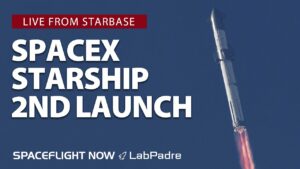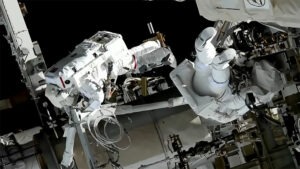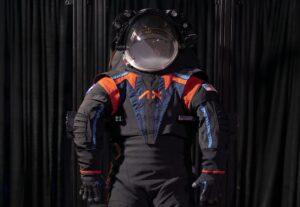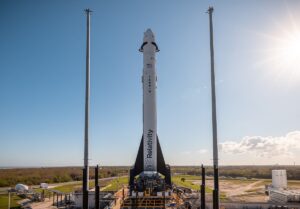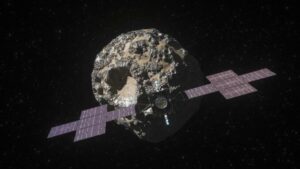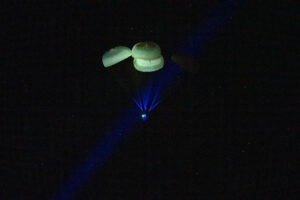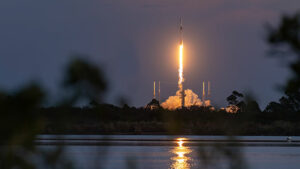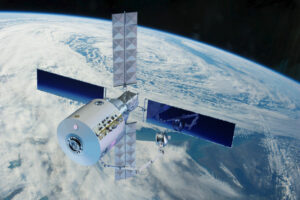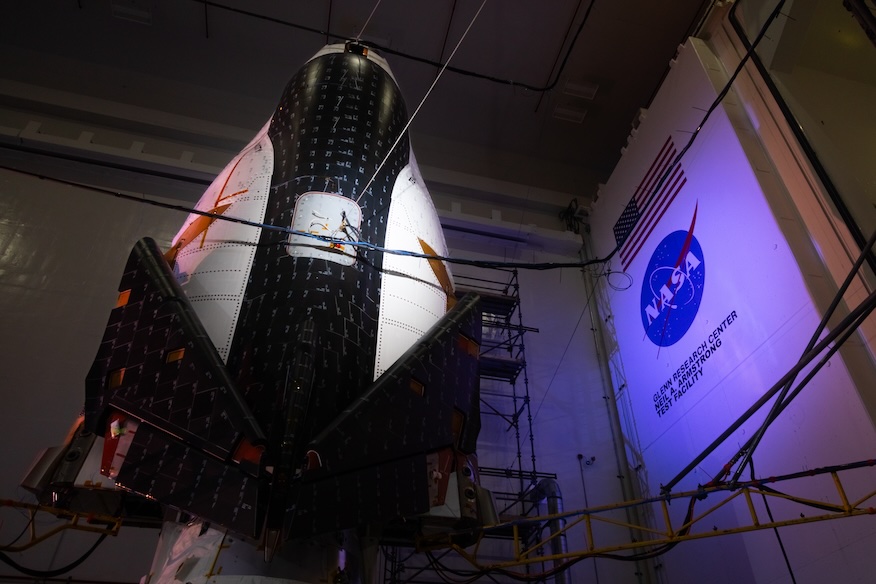
An orbital-class spaceplane is one step closer to returning to the International Space Station. As part of an on-going test campaign, Sierra Space mated its Dream Chaser spaceplane to its Shooting Star module for the first time at NASA’s Neil Armstrong Test Facility in Sandusky, Ohio.
The spaceplane will be the third and final cargo spacecraft contracted by NASA to shuttle supplies and science experiments to the International Space Station as part of the Commercial Resupply Services 2 (CRS-2) contact. In 2016, Northrop Grumman, Sierra Space and SpaceX were awarded several flights each under the agreement that had a maximum value of $14 billion.
“It brings all of us at Sierra Space a great sense of pride and a profound reflection that what we are doing is truly important,” said Tom Vice, the CEO of Sierra Space. “The work we are doing will change everything and it will lay new footsteps for the next generation to follow.”
The company faced several years of development delays in getting Dream Chaser to this point. But recently, the spaceplane, dubbed ‘Tenacity,’ began its final slate of testing before it’s shipped down to Florida for launch.
“We are coming out of years of development, years of hard work, years of resolving really tough engineering challenges that come from revolutionizing the way we do things,” Vice said. “And we are really excited that this year we enter orbital operations for NASA. It is a year that we change how we connect Earth and space.”
[embedded content]
Currently, Tenacity and its Shooting Star module are positioned on top of the shake table inside the NASA’s Mechanical Vibrations Facility at ATF. Jimmy Kenyon, the director of NASA’s Glenn Research Center in nearby Cleveland, Ohio, described it as “the world’s largest and highest capacity spacecraft shaker system.”
“This facility has been home to and has been responsible for critical mission testing of the Orion spacecraft as well as other vehicles, allowing us to understand the harsh flight environment before they actually go to the launchpad,” Kenyon said.
Since early January, Dream Chaser has been put through several shake tests, both horizontally and vertically, to simulate the vibrations from both launch and landing. A Sierra Space spokesperson said this phase of testing should wrap up in the next couple of days.
It will next be moved to the In-Space Propulsion Facility where it will undergo testing in environments that simulate the harshness of being on-orbit.
“We’re going to install the vehicle into the facility, we’re going to pump down the pressure and the temperature to the very low pressures and very low temperatures that the spacecraft will experience as it enters orbit,” Kenyon said. “And then, we’re going to use a dynamic heating element to go around and simulate the heating environment that would be experienced by the spacecraft due to the Sun, the solar heating while it’s there on orbit.”
There’s no set timeline for how long the next phase of testing will last, but Kenyon said the plan is to be able to ship the Dream Chaser and its Shooting Star module down to the Kennedy Space Center in Florida for a launch in the first half of the year.
Return of orbital spaceplanes
The flight of the Dream Chaser Tenacity will mark the first of seven contracted cargo missions for Sierra Space to the ISS. On Thursday, Vice said Tenacity will be used to fly their first four flights while they work to bring their next spaceplane, dubbed ‘Reverence.’
“Dream Chaser was designed from the beginning to one, be highly reusable, highly reliable, focused around turning the vehicle quickly,” Vice said. “We’re going to learn a lot between the first and the second mission, still learning as we get into the third and fourth, but long term, it is our intent to turn the vehicle, get it flying and get it back up and service the customers.”
Vice said the vehicle is designed for 15 missions, but believes that it will be able to go well beyond that.

Following this first mission, NASA will have to map out the manifest for cargo flights between Northrop Grumman’s Cygnus, SpaceX’s Cargo Dragon and Dream Chaser. Phil Dempsey, the technical manager of NASA’s ISS Vehicle Office, said they haven’t mapped out a monthly cadence for these flights just yet.
“We don’t plan our actual cadence that far out. What we do is we take a look at the overall capability that we need. And so, if you look today, we’ve got missions procured through 2026 across all three of the providers,” Dempsey said. “As we go forward, looking to get through the rest of the decade, we’ll take a look at the capabilities as well as the ISS needs and go determine that.”
One of the features unique to Dream Chaser, compared to Dragon or Cygnus, is its ability to land on commercial runways at airports beyond those at the Kennedy Space Center or Vandenberg Space Force Base. Vice said for now, they will focus on landing at those two principle sites to best accommodate the CRS missions, but other opportunities will come into the mix as they mature the vehicle.
“We’re a company that focuses on servicing a billion people. We’re not a company that’s focused on niche markets. And so, designing Dream Chaser to be able to land at runways and take advantage of a worldwide infrastructure, the amount of capital that’s been built, of building runways that can house a 737 or an A320 NEO, that was a design parameter for us and we’ve been able to take advantage of that,” Vice said.
“The reason why we spent so many years pushing the state of the art in hydrogen peroxide and RP-1, refined kerosene, was to make sure that we had the kind of fuels that didn’t have the hazardous materials, the hypergolics,” he added. “And so, that’s enabled us to think about ways in which we can position Dream Chasers in hubs around the world.”
Vice mentioned that they are in discussions with Japan to be able to launch and land Dream Chasers in that country. They are also looking for other opportunities around the world.
Tom Marshburn, a former NASA astronaut and current chief medical officer for Sierra Space said he’s envious of the Crew-8 and Soyuz MS-25 astronauts who will be receiving Dream Chaser when it arrives at the ISS for the first time. He flew two space shuttle missions in addition to Crew-3 flight before he retired from the astronaut corps last year.
“That shuttle shape is very iconic and they’ll be very happy to see this arrive again at space station: a winged vehicle, a lifting body arriving,” Marshburn said. “I’m a little bit envious [of] seeing it. Wishing I could be there once it’s in space, but at the same time, as we’ve talked about, just an enormous amount of humility to see what’s been accomplished when so many great minds get together to build something like this.”

- SEO Powered Content & PR Distribution. Get Amplified Today.
- PlatoData.Network Vertical Generative Ai. Empower Yourself. Access Here.
- PlatoAiStream. Web3 Intelligence. Knowledge Amplified. Access Here.
- PlatoESG. Carbon, CleanTech, Energy, Environment, Solar, Waste Management. Access Here.
- PlatoHealth. Biotech and Clinical Trials Intelligence. Access Here.
- Source: https://spaceflightnow.com/2024/02/02/sierra-space-unveils-fully-integrated-dream-chaser-spaceplane-amid-testing-campaign/
- :has
- :is
- :not
- :where
- $UP
- 1
- 15%
- 2016
- 2024
- 2026
- 678
- a
- ability
- Able
- About
- accommodate
- accomplished
- across
- actual
- actually
- Adam
- added
- addition
- ADvantage
- again
- Agreement
- Airports
- All
- Allowing
- also
- Amid
- amount
- an
- and
- ARE
- Armstrong
- around
- Arrives
- arriving
- Art
- AS
- astronaut
- At
- awarded
- back
- base
- BE
- been
- before
- began
- Beginning
- being
- believes
- BEST
- between
- Beyond
- Billion
- Bit
- body
- both
- bring
- Brings
- build
- Building
- built
- but
- by
- Cadence
- Campaign
- CAN
- capabilities
- capability
- Capacity
- capital
- Cargo
- Center
- ceo
- challenges
- change
- chief
- cleveland
- closer
- come
- coming
- commercial
- company
- compared
- Connect
- contact
- content
- corps
- could
- country
- Couple
- critical
- Current
- Customers
- Days
- decade
- delays
- described
- Design
- designed
- designing
- Determine
- Development
- Director
- discussions
- do
- doing
- Dont
- down
- Dragon
- dream
- dubbed
- due
- dynamic
- each
- Early
- earth
- element
- embedded
- enabled
- Engineering
- enormous
- Enter
- Enters
- Environment
- environments
- everything
- excited
- experience
- experienced
- experiments
- faced
- Facility
- far
- Features
- Feb
- final
- First
- first time
- flight
- Flights
- florida
- flying
- Focus
- focused
- focuses
- follow
- For
- Force
- Former
- Forward
- four
- Fourth
- from
- fuels
- fully
- generation
- get
- getting
- Go
- going
- got
- great
- great minds
- had
- Half
- happy
- Hard
- hard work
- Have
- he
- High
- highest
- highly
- Home
- House
- How
- http
- HTTPS
- Hubs
- humility
- hydrogen
- i
- iconic
- if
- image
- Impact
- important
- in
- Infrastructure
- inside
- install
- integrated
- intent
- International
- international space station
- into
- ISS
- IT
- ITS
- January
- Japan
- jimmy
- jpg
- just
- Key
- Kind
- Land
- landing
- largest
- Last
- Last Year
- launch
- Launchpad
- lay
- LEARN
- learning
- lifting
- like
- little
- Long
- Look
- looking
- Lot
- Low
- make
- manager
- many
- map
- mark
- Markets
- materials
- mature
- max-width
- maximum
- mechanical
- medical
- mentioned
- minds
- Mission
- missions
- mix
- module
- monthly
- moved
- name
- Nasa
- Near
- Need
- needs
- NEO
- New
- next
- niche
- no
- now
- of
- Office
- Officer
- Ohio
- on
- once
- ONE
- Operations
- opportunities
- or
- Orbit
- Other
- our
- out
- overall
- parameter
- part
- People
- phase
- PHIL
- plan
- plato
- Plato Data Intelligence
- PlatoData
- Point
- position
- positioned
- pressure
- pride
- principle
- procured
- profound
- propulsion
- providers
- pump
- Pushing
- put
- quickly
- really
- reason
- receiving
- recently
- refined
- reflection
- reliable
- research
- resolving
- responsible
- REST
- returning
- reusable
- Revolutionizing
- s
- Said
- same
- Science
- Second
- see
- seeing
- sense
- service
- Services
- servicing
- set
- seven
- several
- Shape
- Shield
- ship
- shipped
- shooting
- should
- simulate
- Sites
- Slate
- So
- solar
- some
- something
- Space
- Space Force
- space station
- spacecraft
- SpaceX
- spent
- spokesperson
- Star
- State
- station
- Step
- Still
- structure
- Sun
- supplies
- sure
- system
- table
- Take
- Technical
- term
- test
- Testing
- tests
- that
- The
- The State
- the world
- their
- then
- There.
- These
- they
- things
- think
- Third
- this
- this year
- those
- three
- Through
- thursday
- time
- timeline
- to
- today
- together
- tom
- top
- tough
- truly
- TURN
- Turning
- two
- under
- undergo
- undergoes
- understand
- unique
- Unveils
- us
- use
- used
- value
- vehicle
- Vehicles
- vertically
- very
- vice
- was
- Way..
- ways
- we
- WELL
- were
- What
- when
- which
- while
- WHO
- why
- will
- wishing
- with
- Work
- world
- world’s
- worldwide
- would
- wrap
- year
- years
- yet
- you
- youtube
- zephyrnet

